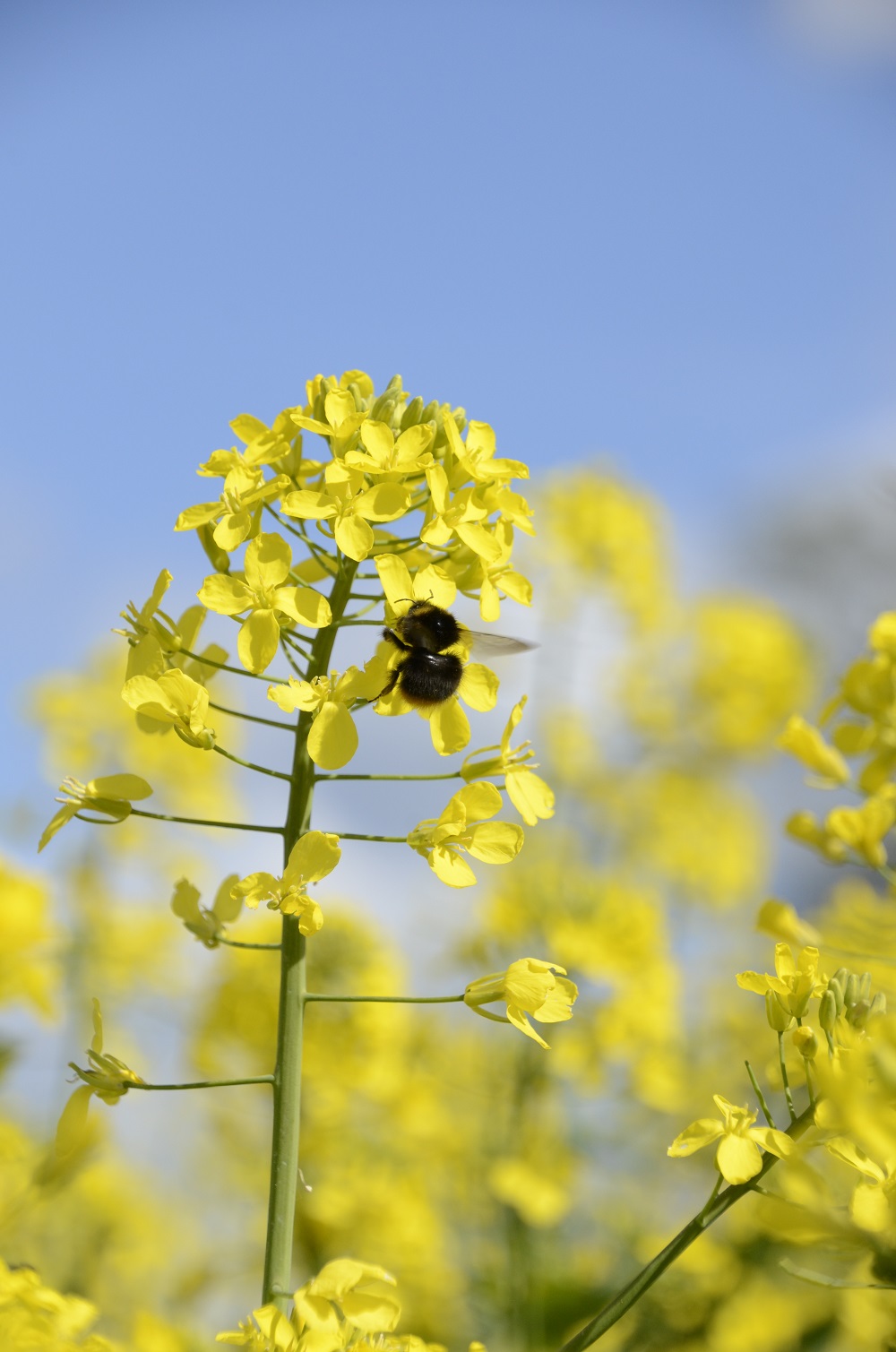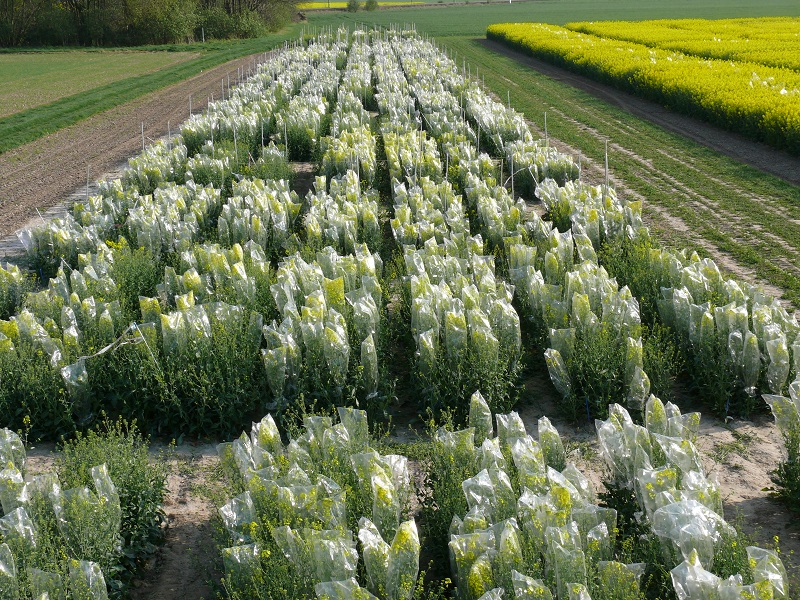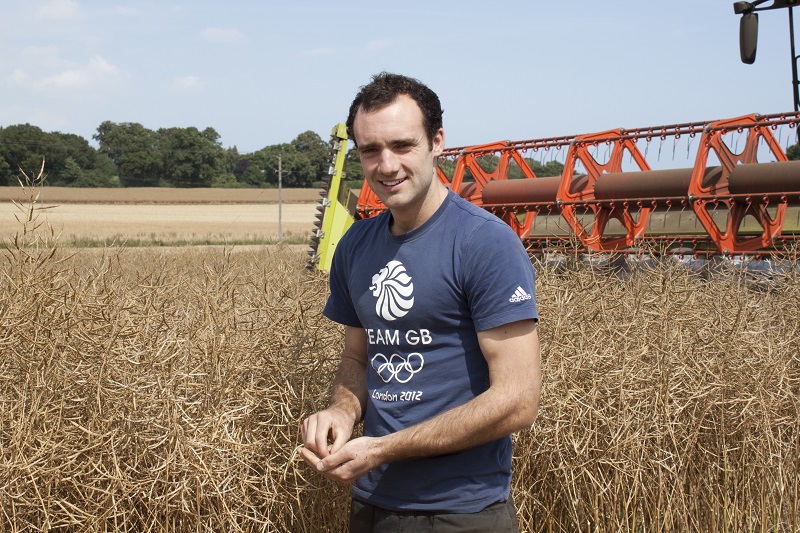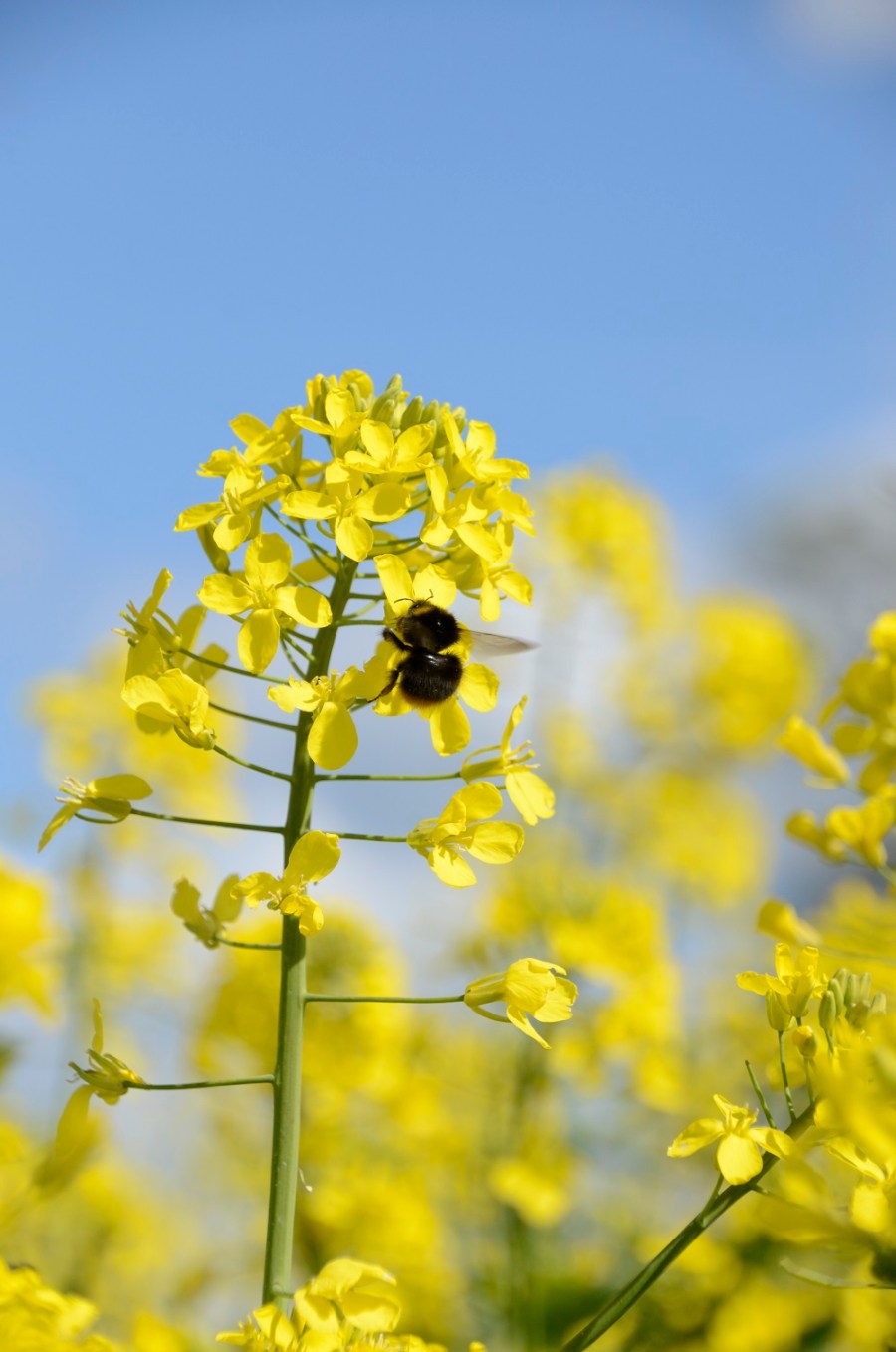In a post neonicotinoid era, European breeder DSV believes it has the answer in the form of its new oilseed rape breeding programme, providing consistent, high performing and low input varieties. Dariot is the first of its new line.
It has a combined disease resistance score that’s among the best on the candidate list.
 By Melanie Jenkins
By Melanie Jenkins
Faced with the prospect of losing neonicotinoids from EU oilseed rape production, alongside other production challenges, DSV has set up a new breeding strategy.
The Post NeoNicotinoid (PNN) programme has been launched with the aim of providing superior early growth, enhanced solar capture, optimum pod presentation and proven performance stability in all OSR varieties going forward. Dariot is the first variety that has demonstrated all of the attributes in the PNN concept, says the breeder, and is currently an AHDB Recommended List (RL) candidate variety in the UK.
DSV took a new approach to breeding for several reasons, according to Alex Döering, international OSR product manager at DSV. “Increasing restrictions on pesticides and fertiliser as well as changes to the environment and the climate are all having an impact on growing OSR,” he says.
“It’s becoming more difficult to licence plant protection products in the EU. By 2015, of all the old and new plant protection products submitted to the EU, the biggest loss was herbicides and insecticides, with 60% not accepted, while about half of the fungicides were not allowed.” He says that the loss of permitted active ingredients is likely to continue, which was a driving factor behind DSV’s development of increased disease resistance in its new varieties.
Insect resilience
Pests have also become more resistant to leading pesticides such as pyrethroids, which is having a detrimental effect all across Europe and not just in the UK. “We have huge problems with insect resilience, and of the 26 products allowed in the EU, a large number of these are pyrethroids and these are limited in their use,” says Alex Döering.
Climate change is another driving force behind PNN. Though prolonged summers and increased temperatures

Plant architecture and disease resistance have been improved, says Alex Döering, as well as N efficiency and insect resistance.
would extend the growth period of OSR, increasing the yield potential and productivity, they could lead to more and new pests, a shorter pod-filling period, reduced soil fertility and increased evapotranspiration, according to Alex Döering.
“While increased precipitation in winter would mean higher water availability, there would also be higher pest pressure, soil erosion, flooding and N leaching,” he notes.
“We need to react to these changes, which is why we’ve changed our breeding strategy, by improving plant architecture and disease resistance – particularly to phoma, LLS and verticillium wilt – plus improving N efficiency and insect resistance,” he adds.
Mike Mann, managing director at DSV UK, says that the elements needed to grow varieties successfully are changing. “In the UK, farmers want a crop to grow quickly and get up out of the ground, and we recognised that the key is to get a good root structure established.”
Primary response
This is where the PNN concept of superior primary response comes into play. “Farmers want to see a big, bushy plant, but what they need is a relatively compact plant on top with a lot of root structure underneath. This is a key attribute of PNN, whereby you plant the OSR, it grows rapidly, puts down a lot of roots quickly and has up to four true leaves but doesn’t go through the extension stage before winter,” he says.
Mike Mann adds that the better root structure also means that there’s more chance of the crop coping with drought or flood conditions.
OSR also needs the root mass to get the N from the soil to drive oil production, which ties in with the enhanced solar capture concept, he says. Dariot is characterised by a high Green Area Index early in the spring/summer with a larger number of small leaves in order to improve N efficiency, so every unit is applied to the plant growth and it continues to deliver, he explains.
However, the height of Dariot under a non-PGR regime can be quite tall, warns Mike Mann. At 162.8cm it’s the second tallest candidate variety, but the inherent stem stiffness and branched plant architecture means this doesn’t affect standing power.
The pod presentation is about reducing the dominance of the apex of the plant, he says. “This means that the main shoot is not taking all the glory but instead Dariot has lots of side branches, so more energy goes into flower and pod production. There’s a better spread of plant in its growing area, maximising seed production.”
Dariot has also been developed to provide stable performance for farmers. “Producing consistent results over the life of the variety in all trials is something DSV has been very successful at,” says Mike Mann. “Farmers need reliability year-on-year and you get a reliable performance with Dariot.” This performance stability also allows Dariot to cope with a wider range of climatic conditions.

The breeding programme aims to select for varieties that put down a lot of roots quickly but don’t go through the extension stage before winter.
As part of testing Dariot’s stability, DSV carried out trials in Oxon, which involved simulating pigeon grazing. “It was planted at a seed rate of 50 seeds/m² in 2014 and was then mowed down on a frosty day in the spring of 2015 to imitate pigeons,” he says.
After six weeks, the heavily grazed plot had bushy plant growth and after 12 weeks the Dariot had grown tall and flowered. The plot that had no imitated grazing yielded around 6.7t/ha, while light grazing was around 6.1t/ha. The plot where stem extension was cut yielded 5.9t/ha and the one with heavy grazing was around 5.5t/ha.
Detlef Hauska, senior OSR breeder at DSV, says that the PNN programme has demonstrated a genetic potential in OSR of 12t/ha.
Good growth habit
Agrii tested Dariot last year in its national network of trials, according to David Leaper. “Dariot has a good growth habit and is consistent with previously successful hybrid varieties,” he says. It fits into the main drilling window but should not be planted early, and suits all soil types.
“Dariot is vigorous in the autumn and relatively quick to grow away in the spring and is an early flowering type. But the stand-out characteristic is the disease resistance, with very good LLS, and the RLM7 gene for phoma resistance.”
Dariot’s LLS resistance did not perform quite as well this year across Agrii’s five replicated trial sites, he notes, compared with some other varieties, but it does have an “excellent” stem canker rating. “It’s fair to say that there was a lot of phoma around in crops last autumn and many growers couldn’t get on the land to spray for it because of the wet conditions, so in those circumstances, having Dariot’s strong genetic resistance will be a real asset.”
David Leaper says that the focus for the AHDB RL has changed in recent years, with more emphasis being put on disease resistance instead of yield. “Last year, only one variety on the candidate list was progressed on gross output alone, while varieties like Dariot were progressed largely on the merit of disease ratings, particularly phoma and LLS, as well as lodging and stem stiffness.”
As the candidate varieties have mostly very similar gross outputs, recommendation is likely to hinge on the disease performance this year, he says. Agrii’s trials showed that Dariot was the eighth most vigorous variety of the 40 varieties trialled, he adds. “Hybrids like Dariot have looked good all autumn and into the spring, and have coped better with the colder spring this year.”
Complementary choice
Becki Gibbs of United Oilseeds has seen Dariot at several farm strip trials around the country and was very impressed. “It stood well and looked very clean.” She says that it’s an excellent variety for growers who have OSR in a close rotation and would also be highly suitable for growers in the South and East of the UK. “It’s also a good complementary choice to grow alongside varieties like Incentive, which has proved a hugely popular option among farmers.”
It has an outstanding disease profile, says Becki Gibbs, who expects it to make inroads into the market share of many hybrid varieties. “It has a combined disease resistance score that’s among the best on the candidate list, with a 9 for stem canker and 6 for LLS.” It also scores 8 for resistance to lodging and offers growers an oil content of 45.4%.
Nidera’s Russell Frost also likes the good agronomic scores. “The 9 for phoma resistance is impressive. LLS is going to be important in the future, especially for those further North, but with a 6 for that as well, Dariot seems to have everything covered,” he says.
Although the mild conditions have not really challenged it, crops of Dariot in the ground established well and look really healthy, he notes. “The Dariot crops are definitely not as forward as some we have seen and it’s interesting how it seems to have exceptional Autumn vigour and then another growth phase in the Spring but then levels out before this becomes troublesome.
“I think a lot of people will welcome the trademark establishment and yield consistency that we’ve come to expect from DSV varieties but now with a good disease-resistance package.”
Impressed with the vigour
Chris Middleditch currently has a 22ha plot of Dariot in the ground at Raveningham Farms, Beccles, Norfolk. It was direct drilled on 16 Aug 2015 using a Sumo drill with fertiliser and slug pellets at a rate of 3.0kg/ha.
“Drilling the seed down the leg allowed for a better root to develop,” he says. “The seed went in well just before rain so it couldn’t have had a better establishment.”
Despite pressure from a high slug population requiring a second application of pellets, the crop got away well and was very vigorous, matching the three fields of Incentive planted next to it.
On 17 Aug R&R Farms applied a pre-emergence herbicide, with Centium (clomazone) applied on 6 Sept and Falcon (propaquizafop) on 9 Sept. In mid-Nov, he gave the crop a dose of Kerb (propyzamide), even though the Dariot plot didn’t have much of a blackgrass issue; other parts of the farm fared worse.
He’d purposefully drilled the Dariot in 600mm strips to increase the amount of branching, but it also helps to target blackgrass with the sprayer, he says. Although the crop was fairly clean it also received a dose of Proline (prothioconazole) in mid-Nov.
The first application of fertiliser went onto the crop on 25 Feb 2016, with liquid N-22 applied at a rate of 360 l/ha. On 19 March a potash and magnesium blend was applied in a solid pass, with Proline then applied on 25 March and a top-up of fertiliser on 5 April.
The crop suffered from some pigeon damage as it was surrounded by woods, with small headland areas mostly affected. “This is why I wanted a vigorous variety so it would grow away,” says Chris Middleditch.
“I’ve been impressed with it – it has held up well and although the bits that were pigeon damaged are shorter, they did progress well. In general, it has pushed on really well.”

Chris Middleditch was looking for a vigorous variety that would grow away from pigeon damage.
Chris Middleditch found it surprising that he did not have to apply a second PGR as with other OSR on the farm. Although vigorous in early establishment, Dariot did not race away in the Spring, creating unwanted canopy development.
Like all OSR across the country, crops were late to pod which could affect yields generally, Chris Middeditch says. “I’m not expecting the same yields as last year, as OSR is just shorter in general.”
He has around 387ha of OSR in the ground, with about half of this down to Incentive and the remaining half split between Tactic and Charger. “Unless Dariot doesn’t yield, I can’t see why I wouldn’t grow it again,” he says. “But the higher the oil content, the better.”
Taken well to challenging soils
After seeing some results from a local field trial, Nick Down decided to grow Dariot at Green Drove Farm, Pewsey, Wilts, as it was one of the highest yielding varieties on a similar soil type.
He currently has a 14ha field of it, planted on 16 Sept behind a second wheat crop. “We’re trying to widen our OSR rotation so this field hasn’t grown OSR for seven years,” he says. It was conventionally drilled with a Väderstad Rapid at a rate of 60 seeds/m² into a deep clay over Andover series chalk. This soil can be a challenge to turn around in a short period of time, even when the weather is favourable, says Nick Down.
The crop took a while to get going in the autumn but he says most of the OSR he had planted was the same. “We had 120mm of rain during Aug which led to colder soils than we’re used to at that time of year. The slug pressure was high but Dariot soon grew away from it and by mid Oct it had caught up with the late-Aug drilled varieties,” he explains. All crops took a long time to get going in the spring, but Dariot was the first of the OSR into full flower.
“We have to use a belt and braces approach to herbicides,” says Nick Down. “Cranesbill, cleavers and blackgrass are the main enemies, so we can’t afford to hold back.”
He only managed to apply one autumn fungicide, which was followed up at early stem extension, plus one flowering spray. “LLS has been generally more prevalent in all varieties this spring but well timed fungicides seem to have kept it under control.”
Nitrogen was put on at a rate of 180kg/ha, while di-ammonium phosphate was applied pre-drilling. Potash has been applied variably, depending on soil indices and crop off-take, he adds.
“Our location means we don’t get too many other pest issues and despite some shot holing from cabbage stem flea beetle, we haven’t had any issue with the larvae this spring.”
Nick Down is also growing Incentive, SY Harness, PR46W21, and a small area of V316 OL. “Dariot looks to have the edge in terms of vigour, however, we’ll have to wait until harvest to see if that transfers into yield,” he says.
“We’ll definitely be looking at growing it again, as long as the yield is comparable to our other varieties, as the vigour of Dariot, in both autumn and early spring, is a big plus for us.”
Dariot at a glance
| Gross output (%) | 103.6% |
| Treated seed yield (%) | 103.2% |
| Oil content (%) | 45.4% |
| Resistance to lodging | 8.1 |
| Stem stiffness | 6.8 |
| Height (cm) | 162.8 |
| Earliness of flowering | 5.1 |
| Earliness of maturity | 5.8 |
| Resistance to light lead spot | 6.1 |
| Resistance to phoma stem canker | 9.0 |
Source: AHDB Cereals and Oilseeds Winter Oilseed Rape East West Candidate Table 2016/17




